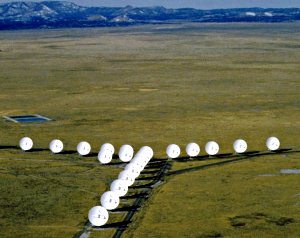 The Very Large Array radio telescope
The Very Large Array radio telescope
facility in New Mexico, the tool used to find a cosmic supervoid.
Credit: National Radio Astronomy Observatory (NRAO)There's been some excitement in the world of cosmology in recent weeks surrounding the discovery of a really, really big "hole" in space--not a black hole, which is a small and matter-dense object, but a vast gulf of emptiness far larger than any other similar voids yet found.
You might say, don't scientists tell us that space in general is pretty much empty, no matter where you look between the stars and planets, or between the galaxies? What's the big deal with finding yet more emptiness out there?
Well, everything is relative. Take a place like the Milky Way Galaxy, for instance. A galaxy is a region of space crowded with matter in the form of gaseous nebulas, dust, stars, planets, moons, asteroids, comets--a bustling "city" of material. Never mind that the huge gaps between the stars are nearly empty space; the point is that a galaxy is a relatively matter-rich zone.
Not so with cosmic voids. Scientists have known of voids for some time. As astronomers have surveyed the universe and pinned down the locations and distances of large numbers of galaxies, a structure to their arrangement has emerged. Galaxies stick together, by gravity, in groups called galaxy clusters, which in turn form larger groupings called superclusters. These clusters and superclusters in turn are arranged in vast membrane-like "sheets" and filaments, like the walls of soap bubbles or sponge cake. Between the sheets and filaments, similar to soap bubbles and sponge cake, are large regions void of material.
The recent and startling discovery, which has caused all the excitement, is of a void that might be as big as a billion light years across! This particular void was discovered by astronomers using the Very Large Array (VLA) radio telescope facility in New Mexico. (The VLA was made somewhat famous in the movie Contact when it received a phone call from an Extra Terrestrial.)
How can we get our heads around the concept of a billion-light-year "bubble" of nothing? Well, we try to get our heads around it with an analogy, such as this: A galaxy the size of the Milky Way, which is 100,000 light years across, sitting on the edge of this billion-light-year void is comparable in scale to a human standing next to the 10-mile-wide Grand Canyon--and feeling very, very small...
